8 Easy Ways to get Hot Water in a Campervan
If you’re anything like me a cold outdoor shower in the middle of winter might not sound very appealing! Luckily, there’s now lots of solutions for getting your campervan equipped with hot water so you can enjoy a lovely (albeit quick!) hot shower no matter where you are.
We knew early on in our van build that we wanted a bathroom in our Sprinter conversion. Eventually we settled on a small but practical space with a urine diverting toilet and a shower. Once we’d decided on the design we set about finding the best solution for getting hot water to our shower. During our research we came across eight ways to get hot water in a campervan which we’ll outline below, including the option we chose for our van.
How to get hot water in a campervan
We’ve found eight different ways to generate hot water in a van. They each come with their own advantages and disadvantages so there isn’t really a one-size-fits-all solution.
When deciding which method will work best for you it’s a good idea to sit down and think about your hot water requirements. A family of four living full time in a van will no doubt require more hot water than a solo weekend traveller.
All the below methods require some kind of energy source, whether that’s via the sun, LPG, diesel or electricity. The great news is there’s lots of solutions for generating hot water in campervans now so it’s easier than ever to wash the dishes, bath the dog and take a shower whatever your budget.
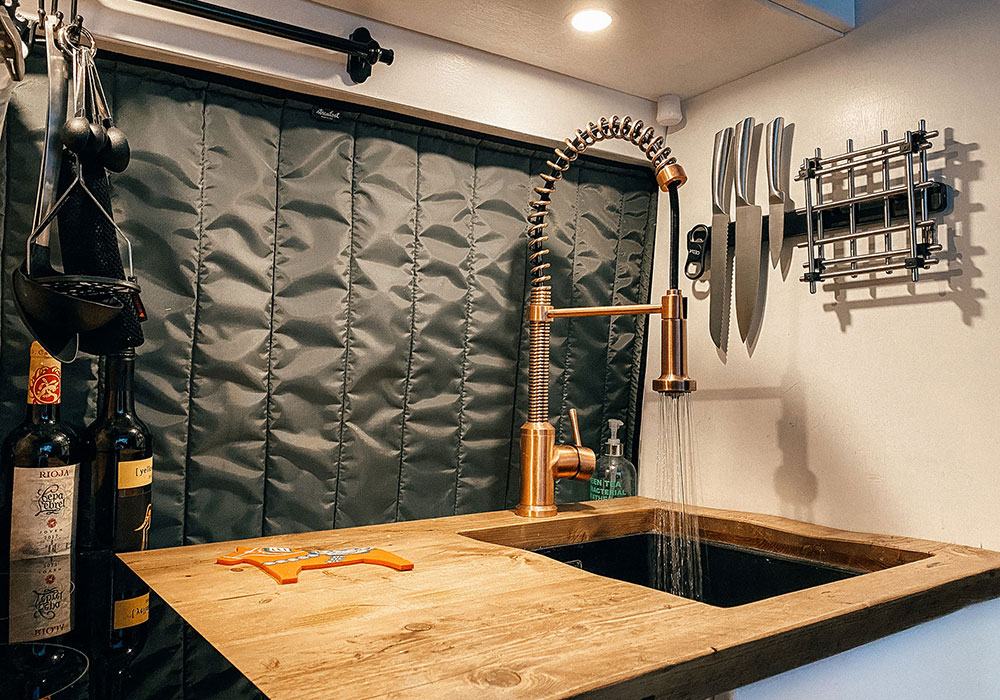
1. Boil water in a pan
This is by far the simplest and easiest option for getting hot water. Whether you use a campfire, wood burner, camping stove or built-in cooktop it’s easy to simply fill a pan or kettle and boil your water. Therefore, if you just want to wash your dishes and have a quick sponge bath this an ideal option. However, if you’re wanting to transfer this to a portable shower it can become less efficient as you need larger amounts of water.
2. Solar shower
One of the things we love about living off grid is using solar power to charge our batteries. Solar is also a great way to heat up water through the use of a solar shower. This is simply a bag filled with water that you leave out in the sun to heat up. When you’re ready to shower simply use the power of gravity and the attached hose/shower head. Some larger solar showers also feature a foot pump for a more powerful flow.
If your budget stretches a little further you could install a Road Shower on the roof of your vehicle (or make your own DIY version). This is essentially a black tube filled with pressurised water that’s heated by the sun. It allows for a higher volume of water than a solar shower but is less portable.
3. Tankless propane water heater
If you don’t want to install a hot water tank but do have gas in your van an instant hot water heater may be a great solution for getting hot water in your campervan. These heaters use an internal heat exchange to warm your water on demand and are therefore efficient as well as easy to install.
There are a large range of options available. You can opt to keep your heater portable and just connect the gas supply when required or install it in your van. If you do the latter, however, make sure you properly vent the unit to ensure combustion gases can fully escape from your van as they are designed to be used outside.
4. Water Tank: Calorifier
A calorifier water tank features an internal coil that’s connected to your engine coolant line. This is the option we use in our van and we absolutely love it! After around 15 minutes of driving we have a full 16lt tank of hot water simply by using the heat from our engine.
As you drive your engine heats up. The coolant line draws heat away from your engine, flows through the coil within your tank, heats the water as it passes through and then flows back to your engine via the radiator.
We have an insulated Isotemp Slim tank that sits behind the baskets in our kitchen. The water stays hot overnight except in very cold weather and it also features an electric heating element as a back up.
Want to know how we installed a calorifier into our van?
We have a full article all about how we use the heat from our engine to get hot water, including all the steps we followed to install the hot water calorifier tank and connect it to our engine. Head to our Hot Water Installation Guide for more information.
5. Water Tank: Gas
If you have space for a water tank and carry LPG on board your campervan a gas powered water heater might be a great option for generating hot water. These water tanks feature an internal gas burner that heats your water to give you a plentiful supply of hot water. Some feature both electric and gas options which can speed up the heating time.
6. Water Tank: Electric
Similar to the above option is installing a water tank with an electric heating element. The main downside of this option is it uses a lot of electricity to heat your water so is really only suitable if connected to mains power.
We used this option for a couple of months when the calorifier element of our tank wasn’t connected and it uses a lot of power! We therefore only heated our water on days we were doing a long drive and could generate power to replenish the battery from our alternator whilst driving. That being said, if we do have mains power we revert to using this method so we don’t have to drive.
7. Combi Heater: Diesel
If you plan on travelling in areas that aren’t always nice and warm you’ll most likely need some kind of heating in your van. Most van conversions we’ve seen install either a gas heater or diesel heater (read more in our Complete Guide to Campervan Heating).
If you opt for a diesel heater it’s worth looking at a combi heater that will heat water as well as the air. Combi heaters work in a similar way to combi boilers in a house. When hot water is needed it’s created by pulling cold water from your campervan tank into your diesel heater boiler and heating it via a heat exchange.
8. Combi Heater: Gas
This option is similar to the above but using LPG instead of diesel as your energy source. All the gas combi heaters I’ve come across have an integrated water tank as opposed to an on-demand system. The water heater can, however, be used with or without the air heater to ensure they’re suitable for summer use.
Looking for more information on our Sprinter van bathroom?
If you’re thinking about installing a bathroom in your van conversion make sure you read our How to Build A Sprinter Van Bathroom guide. This explains everything we used in our build and how we put it all together.
We also have a dedicated Van Bathroom page in our shop so you can easily find links to everything used in our tiny wet room.
What’s the best way to get hot water in a campervan?
It very much depends on your priorities and how you’ll be travelling as to which option will suit you best. If you don’t plan on installing a fixed shower then a fully plumbed in solution is likely overkill, likewise if you’ll always be travelling in warm climates an outdoor solar shower might be perfect.
It’s also advisable to think about the fuel sources you have onboard your van. If you’re planning on installing gas during your van for cooking and heating then it might make sense to utilise this for hot water as well.
You should also bear in mind the space you have available as this will determine whether a hot water tank is viable or an on-demand system will serve you better. Also remember a hot water tank will add weight to your van when full if you’re trying to keep your conversion below 3.5t.
We love the calorifier water tank method as using the heat already generated by your engine seems like a nice efficient and passive solution. It’s worked really well for us so far and it feels like a real luxury having hot water whenever we need it.
If you opt for this method I’d highly recommend a tank with a secondary electric heating element for times when you’re connected to power. For example, this works really well if you’re parked up for a few days at a Stellplatz or campsite.
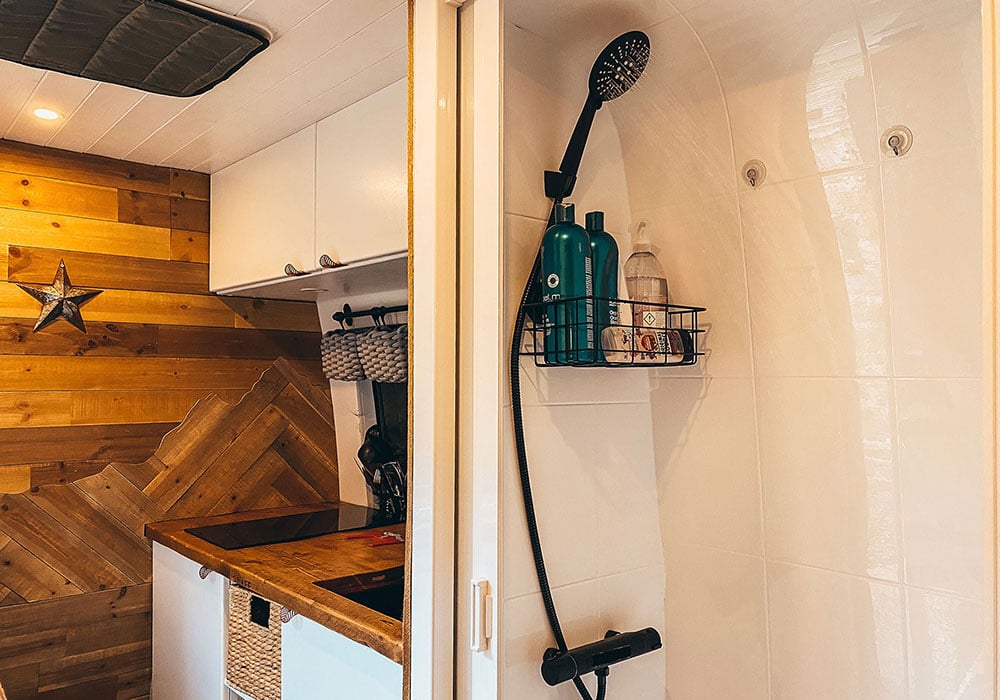
Can you think of any other methods to get hot water in a campervan? We’d love to know if there’s any we’ve missed. Let us know in the comments below if so.
If you’ve found this post useful and would like to support our content (thank you!) you can do so by purchasing one of our van life stickers or magnets. Alternatively you can treat us to a virtual coffee (or tea, or dog treats… you get the idea!)!
This page contains affiliate links. As a result we make a small commission on purchases made through these links at no extra cost to yourselves.
Like this post? Pin it!
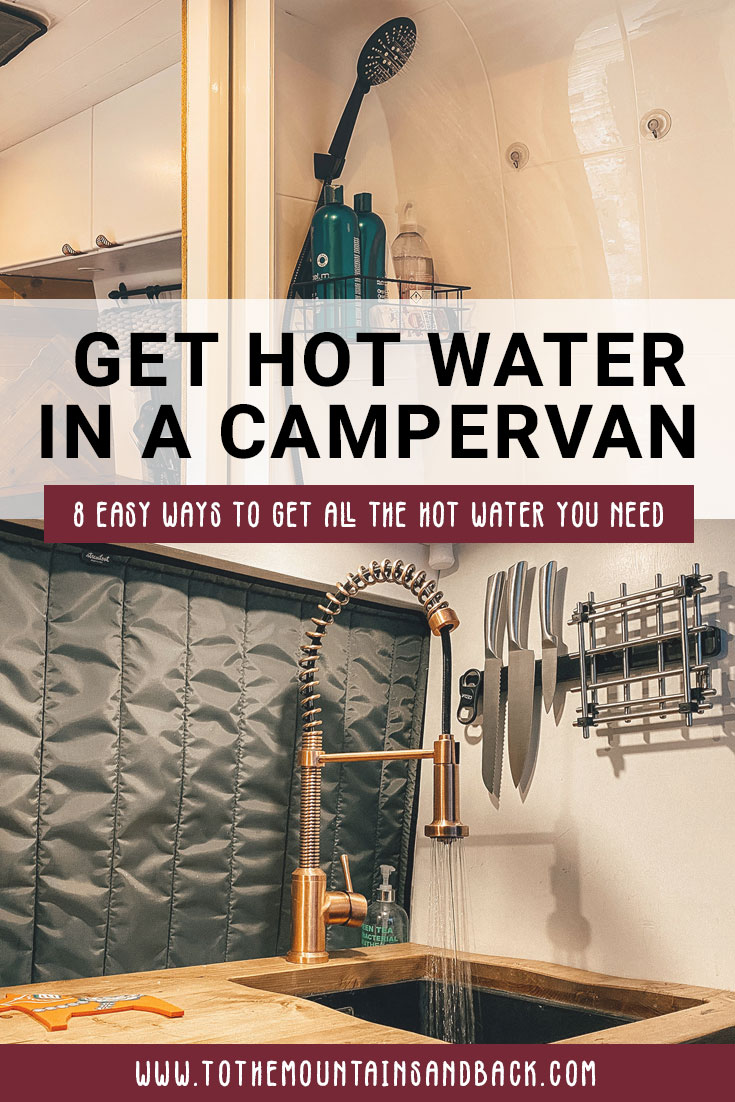


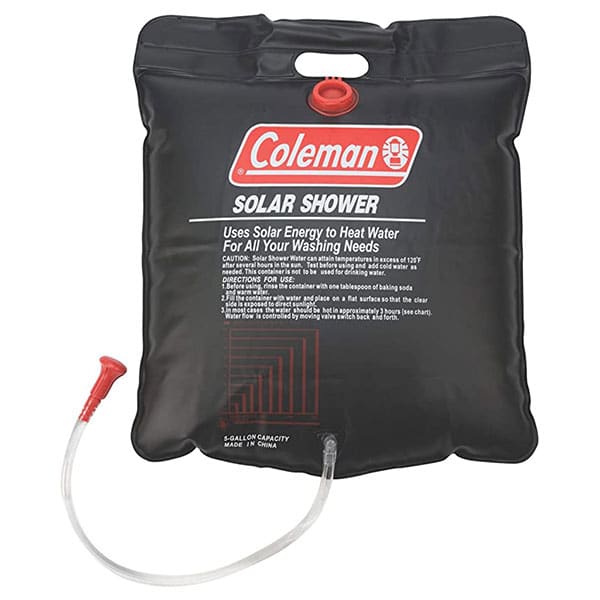
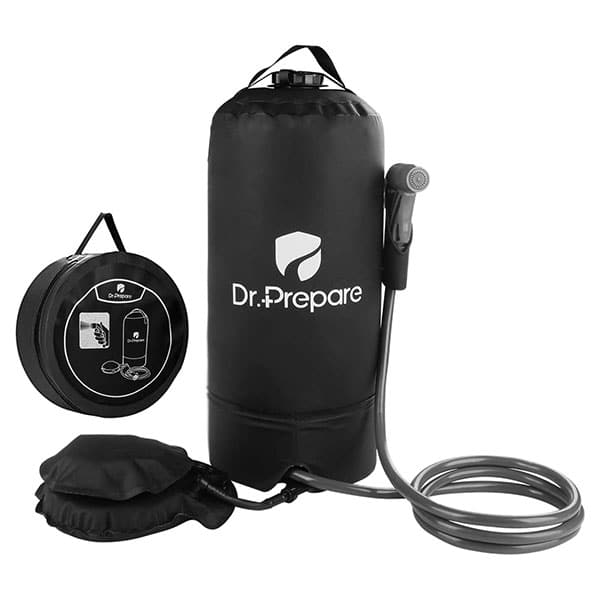

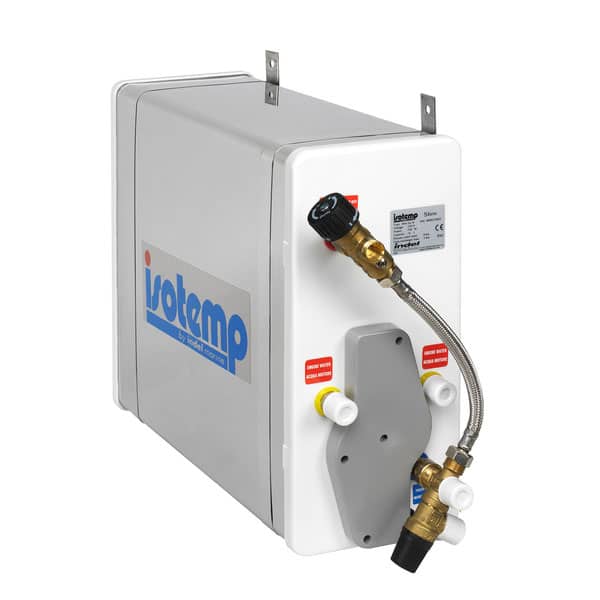
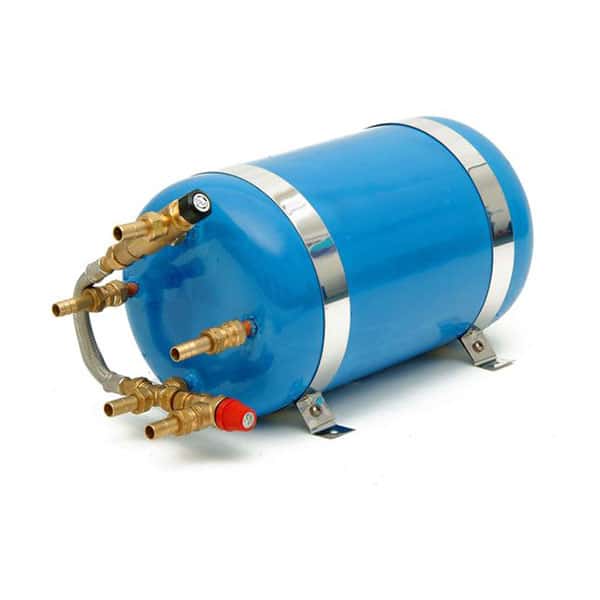


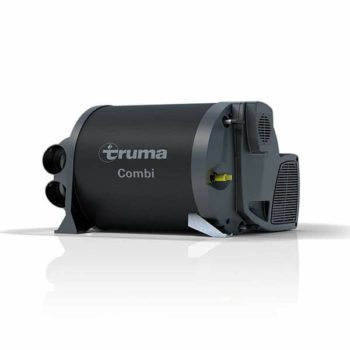

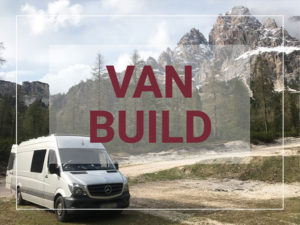

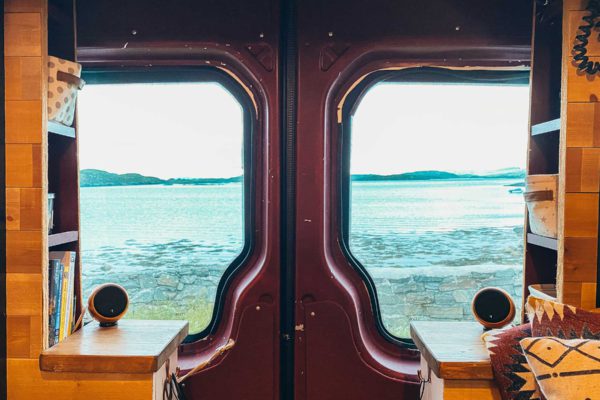
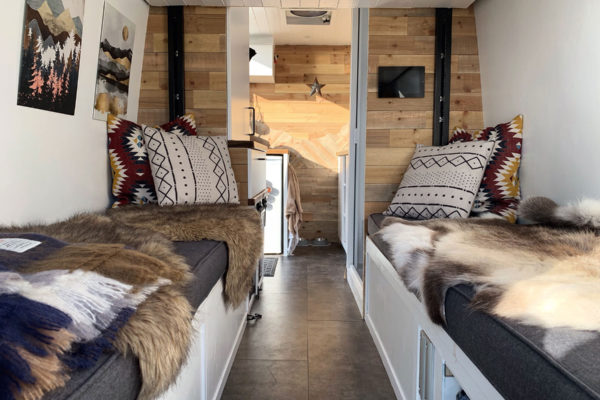
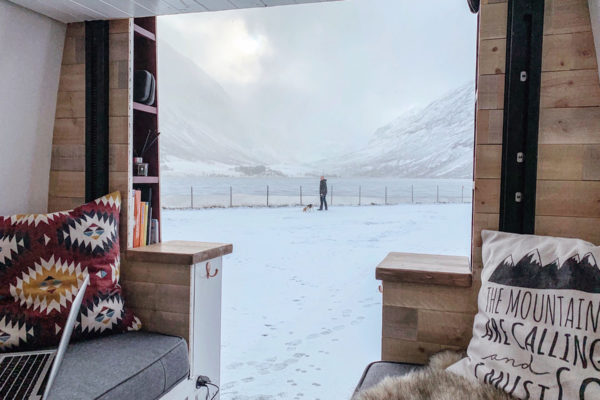
Hi , the next logical step is to refine the calorifier so the back up electric heater can be fed from alternative energy sources including solar and other 12 volt systems (even small windmill?) and still accept a mains plug in. We are looking into this unit .We would appreciate some prices based on a complete system including pipes shower , sink e.t.c
Our leisure battery (which is used by the electric element of the clarifier if heating with electricity) is fed by solar and from our alternator as we drive. Shore power is also possible but we usually stay off grid where we can. It’s very rare we need to use the electric heating option as we usually drive a little every day but if we are parked up for a few days it would use more power than our 500w solar could generate to heat the tank unfortunately. I’m afraid we don’t sell the system ourselves so I can’t provide any prices.
I enjoyed reading the article above, it explains everything in detail, and the article is very interesting and effective. Thank you and good luck with the upcoming articles.
I have a shower that’s portable, ( you can purchase easily ) it has a small submersible pump on one end of pipe, and shower head on other, it has electric cable ( already built into pump ) that goes to battery ( I have clips, but can have it so plugs in ), the cable has a watertight hand switch fitted, so as to switch shower on as you need ( all cable is also watertight, ) my method of heating water is simple, the pump drops into a bucket ( collapsible if needed ) or square bin , I boil a kettle and mix with cold water in the said bucket, alternatively if sun is out, and to save on gas, I throw a solar bag / shower filled with water on to roof or bonnet, heats up quicker off hot bodywork ) and use the hot water in said bucket, this power shower far better than the bag !, for saving on gas using kettle, I have an electric kettle as well, I run off vehicle when engine ticking over, ( cost affective ), it may sound time consuming to set up, but you do get it down to a fine art, 10 mins, I use inside or outside when warm weather, I use a pop up toilet tent if privacy is needed,